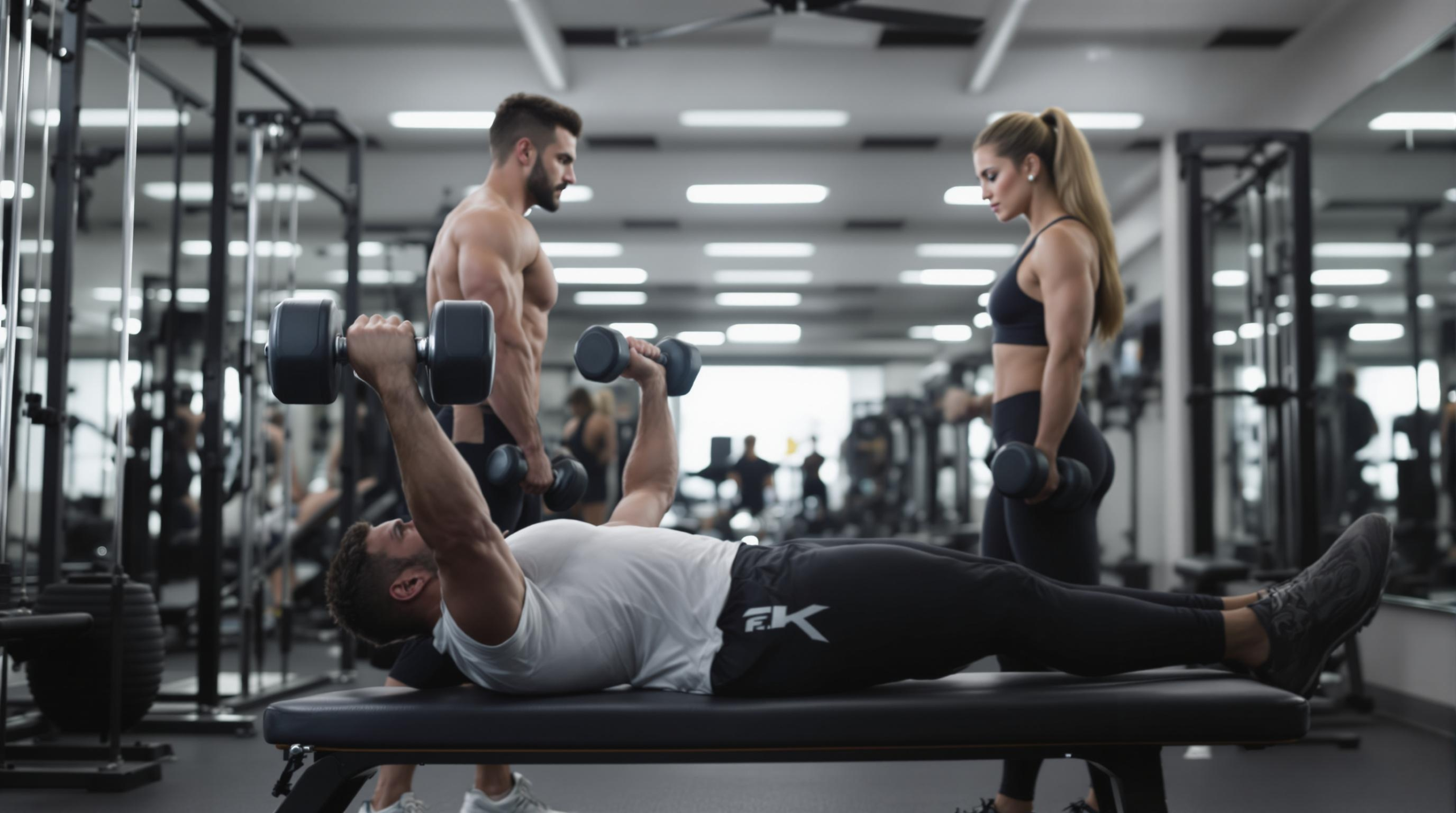
How to Do Dumbbell Exercises Effectively: Form, Routines, and Muscle-Specific Techniques
Preparation Before Exercising with Dumbbells

Before diving into your dumbbell workout, taking the time to prepare properly can make a significant difference in your performance and safety. Here are some essential steps to follow:
1. **Warm-Up**: Start with a 5-10 minute warm-up to increase your heart rate and loosen up your muscles. This could include light cardio like jogging in place, jumping jacks, or dynamic stretches such as arm circles and leg swings. Warming up reduces the risk of injury and prepares your body for the workout ahead.
2. **Check Your Equipment**: Ensure your dumbbells are in good condition, with no loose parts or damage. If you’re using adjustable dumbbells, double-check that the weights are securely fastened. This step ensures safety and prevents accidents during your workout.
3. **Choose the Right Weight**: Select a dumbbell weight that challenges you but still allows you to maintain proper form. If you’re new to strength training, start with lighter weights and gradually increase as you build strength and confidence.
4. **Wear Proper Attire**: Comfortable, breathable clothing and supportive athletic shoes are essential. Avoid loose clothing that could get caught on equipment. Wearing the right gear helps you move freely and focus on your exercises.
5. **Hydrate and Fuel Your Body**: Drink water before your workout to stay hydrated. If you haven’t eaten in a while, consider a light snack with a balance of protein and carbohydrates to fuel your muscles.
6. **Set a Clear Plan**: Outline your workout routine beforehand. Decide which exercises you’ll perform, how many sets and reps, and the order of movements. Having a plan keeps you focused and ensures a balanced workout.
By following these preparation steps, you’ll set yourself up for a safe, effective, and enjoyable dumbbell workout. Remember, preparation is just as important as the workout itself!
Muscle-Specific Dumbbell Workouts: Arms, Shoulders, Chest, Back, Legs

Dumbbell exercises are a fantastic way to target specific muscle groups, build strength, and improve overall fitness. By focusing on proper form and a well-structured routine, you can maximize your results and reduce the risk of injury. Below, we’ll break down effective dumbbell workouts for each major muscle group: arms, shoulders, chest, back, and legs.
**1. Arms:**
For toned and strong arms, focus on bicep curls and tricep kickbacks. Bicep curls target the front of your arms, while tricep kickbacks strengthen the back. Keep your elbows close to your body and avoid swinging the weights to maintain proper form.
**2. Shoulders:**
Dumbbell shoulder presses and lateral raises are excellent for building shoulder strength and definition. For shoulder presses, push the dumbbells upward from shoulder height, and for lateral raises, lift the dumbbells to the side until they’re at shoulder level. Always keep your movements controlled.
**3. Chest:**
Dumbbell bench presses and chest flies are ideal for targeting the chest muscles. For the bench press, lie on a bench and press the dumbbells upward. For chest flies, keep a slight bend in your elbows and open your arms wide before bringing them back together.
**4. Back:**
Dumbbell rows and reverse flies are great for strengthening your back. For rows, hinge at the hips and pull the dumbbells toward your waist. For reverse flies, hinge forward and lift the dumbbells outward, squeezing your shoulder blades together.
**5. Legs:**
Dumbbell squats and lunges are perfect for building leg strength. Hold the dumbbells at your sides for added resistance. Keep your back straight and engage your core to protect your lower back.
Remember, consistency is key! Start with lighter weights to master your form before progressing to heavier dumbbells. Pair these exercises with a balanced diet and proper rest for optimal results.
Optimized Training Strategies: Tempo, Breathing, and Recovery

When it comes to maximizing the effectiveness of your dumbbell exercises, paying attention to tempo, breathing, and recovery is essential. These three factors can significantly impact your workout results and overall fitness progress.
**1. Tempo:** The speed at which you perform each repetition matters more than you might think. Slowing down your tempo during the eccentric (lowering) phase of a movement can increase muscle tension and lead to greater strength and hypertrophy gains. For example, during a dumbbell bench press, take 3-4 seconds to lower the weights to your chest, pause briefly, and then push back up with controlled power. A slower tempo also helps improve your form and reduces the risk of injury.
**2. Breathing:** Proper breathing techniques can enhance your performance and prevent unnecessary fatigue. Always exhale during the exertion phase (e.g., lifting the dumbbell) and inhale during the relaxation phase (e.g., lowering the dumbbell). For instance, in a dumbbell bicep curl, exhale as you curl the weight up and inhale as you lower it. Controlled breathing not only stabilizes your core but also helps maintain focus during challenging sets.
**3. Recovery:** Recovery is where the magic happens. Without adequate rest, your muscles won’t have the time they need to repair and grow stronger. Make sure to include rest days in your routine and prioritize quality sleep. Additionally, active recovery, such as light stretching or yoga, can help reduce muscle soreness and improve flexibility. Remember, recovery isn’t just about resting; it’s about giving your body the tools it needs to perform better in the long run.
By focusing on these three strategies, you can take your dumbbell workouts to the next level, ensuring that every rep counts and that your fitness journey is both effective and sustainable.
Common Mistakes to Avoid and Safety Tips

When it comes to dumbbell exercises, ensuring proper form and technique is essential not only for maximizing results but also for preventing injuries. Here are some common mistakes people make and safety tips to help you exercise effectively and safely:
1. **Mistake: Using Too Much Weight Too Soon**
Many beginners tend to overestimate their strength and choose dumbbells that are too heavy. This can lead to poor form, reduced range of motion, and even injuries.
**Tip:** Start with a manageable weight that allows you to complete the exercise with proper form. Gradually increase the weight as your strength improves.
2. **Mistake: Poor Posture and Form**
Slouching, arching your back, or swinging the dumbbells are common errors that can reduce the effectiveness of your workout and strain your joints.
**Tip:** Focus on maintaining a neutral spine, engaging your core, and performing slow, controlled movements. If you’re unsure about your form, consider working with a trainer or using a mirror to self-check.
3. **Mistake: Skipping Warm-Ups and Cool-Downs**
Jumping straight into heavy lifting without warming up can increase the risk of muscle strain. Similarly, skipping cool-down stretches can lead to stiffness and delayed recovery.
**Tip:** Always dedicate 5-10 minutes to dynamic warm-ups before your workout and static stretches afterward to improve flexibility and reduce soreness.
4. **Mistake: Holding Your Breath**
Holding your breath during exercises can cause unnecessary tension and even dizziness.
**Tip:** Practice proper breathing techniques. Exhale during the exertion phase (e.g., lifting the dumbbell) and inhale during the relaxation phase (e.g., lowering the dumbbell).
5. **Mistake: Neglecting Safety Equipment**
Not using gloves or a secure grip can lead to dumbbells slipping from your hands, especially during sweaty workouts.
**Tip:** Use gloves or chalk for a better grip, and always ensure the dumbbells are securely fastened if they are adjustable.
By avoiding these common mistakes and following these safety tips, you can enjoy a more effective and injury-free workout. Remember, consistency and proper technique are the keys to long-term success in fitness!



